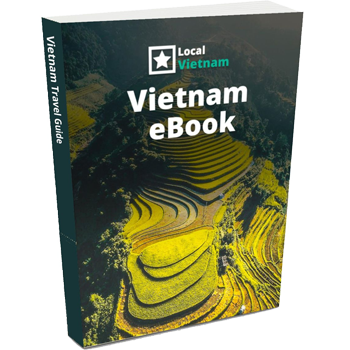What is Bao Quoc Temple like?
Bao Quoc Temple is a peaceful Buddhist temple located on Ham Long Hill, just a short drive from Hue’s city center. It has a long history dating back to the 1600s and was once supported by Vietnam’s emperors.
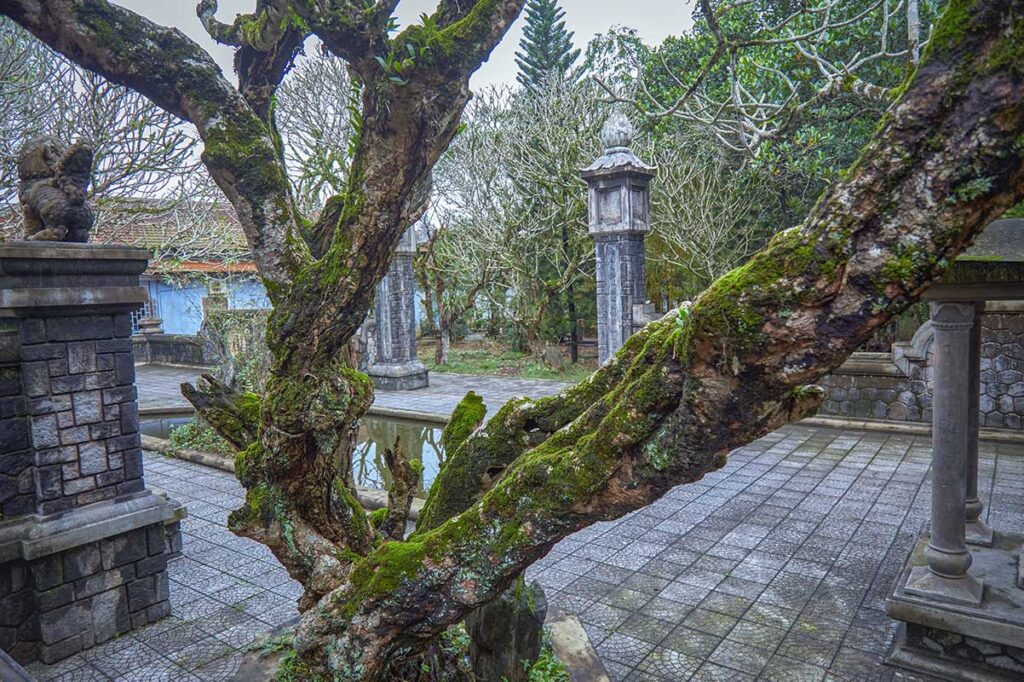
The temple is surrounded by trees and gardens, with quiet paths, old stupas, and a simple but beautiful prayer hall. It’s not a big tourist site, but a calm place where you can learn about Vietnamese Buddhism and enjoy a more local, spiritual side of Hue.
History of Bao Quoc Temple
Founding and early history
Bao Quoc Temple was founded in 1670 by Zen Master Thich Giac Phong, a monk from China. It was originally named Hàm Long Sơn Thiên Thọ Tự, and built in the shape of the ancient Nom character for “mouth” (khẩu), reflecting Vietnamese-Chinese spiritual design influences.
In 1747, Lord Nguyen Phuc Khoat gave it the royal title “Sac Tu Bao Quoc Tu,” officially recognizing it as a national pagoda under Nguyen rule.
Royal patronage and renovation
The temple received major support from Vietnamese royalty over the centuries:
- 1808 – Empress Hiếu Khương, wife of Emperor Gia Long, funded the construction of the triple gate, and the casting of a large 826-kg bell.
- 1824 – Emperor Minh Mang visited the temple, renamed it to Bao Quoc, and held ceremonial events here.
- 1858 – Emperor Tu Duc provided funds for restoration as part of a broader imperial preservation effort.
Monastic education and Buddhist revival
In the early 20th century, Bao Quoc became a center for Buddhist education and reform:
- 1935 – A Buddhist school was opened on the grounds.
- 1940 – A monastery for training monks was added.
- 1959–1975 – The Ham Long Bodhi School operated here, offering primary and secondary education until it closed following the reunification of Vietnam.
Present day use
Today, Bao Quoc Temple remains spiritually active, serving both as a place of worship and as a quiet training ground for monks. While it’s no longer a formal education center, its role in Vietnamese Buddhist history remains deeply respected.
Highlights of Bao Quoc Temple
The temple sits on Ham Long Hill, with a 2-hectare campus surrounded by mature trees, shrines, and peaceful garden paths. While it lacks the grandeur of royal tombs or large pagoda complexes, Bao Quoc Temple offers a tranquil space full of symbolic architecture, sacred relics, and spiritual atmosphere.
1. Tam Quan Gate (Triple Entrance Gate)
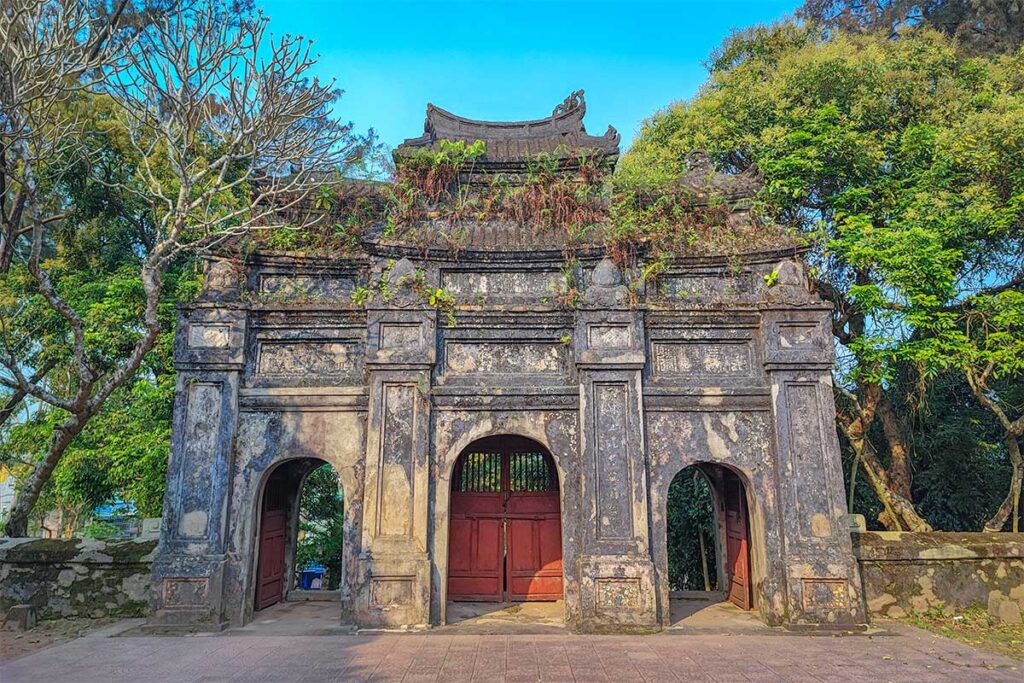
The entrance to the temple is marked by a large moss-covered stone gate with three arches, known as the Tam Quan. This is a classic feature in Vietnamese Buddhist temples, symbolizing the three gates of liberation in Buddhist philosophy. It’s the first signal that you’re entering a place of quiet reflection.
2. Grand staircase and garden courtyard
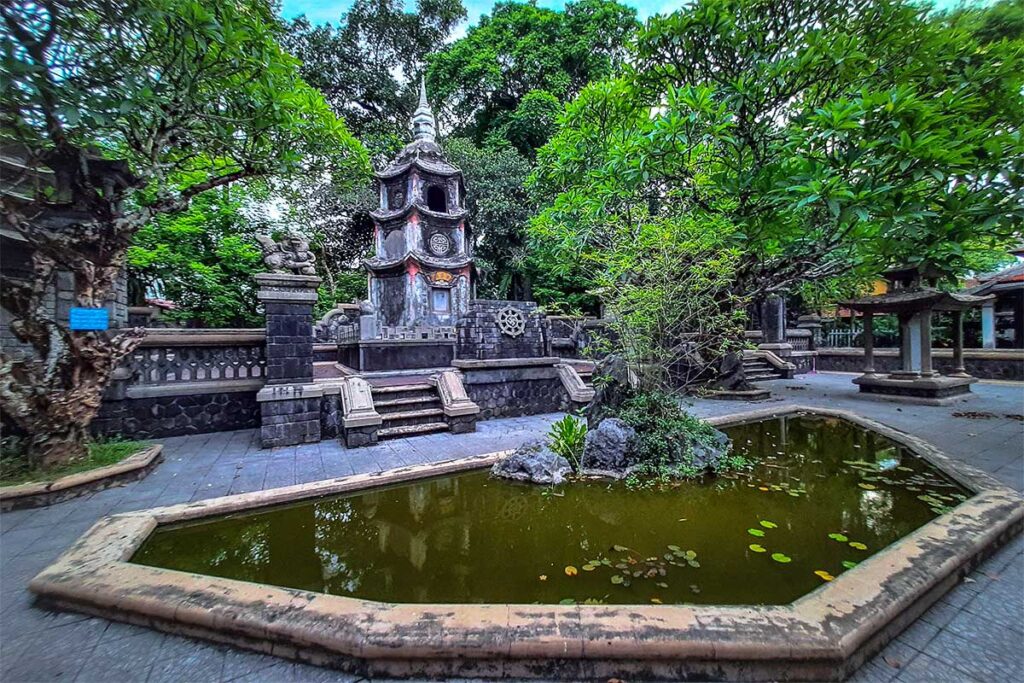
From the gate, a long stone staircase winds gently uphill through a garden shaded by tall trees. The walk up adds to the atmosphere, offering a quiet, meditative transition from the outside world into the temple grounds.
3. Main Hall

The central prayer hall is both simple and rich in symbolism. Inside, you’ll find a triple Buddha statue, altars with offerings, and walls adorned with porcelain inlays and carved wood.
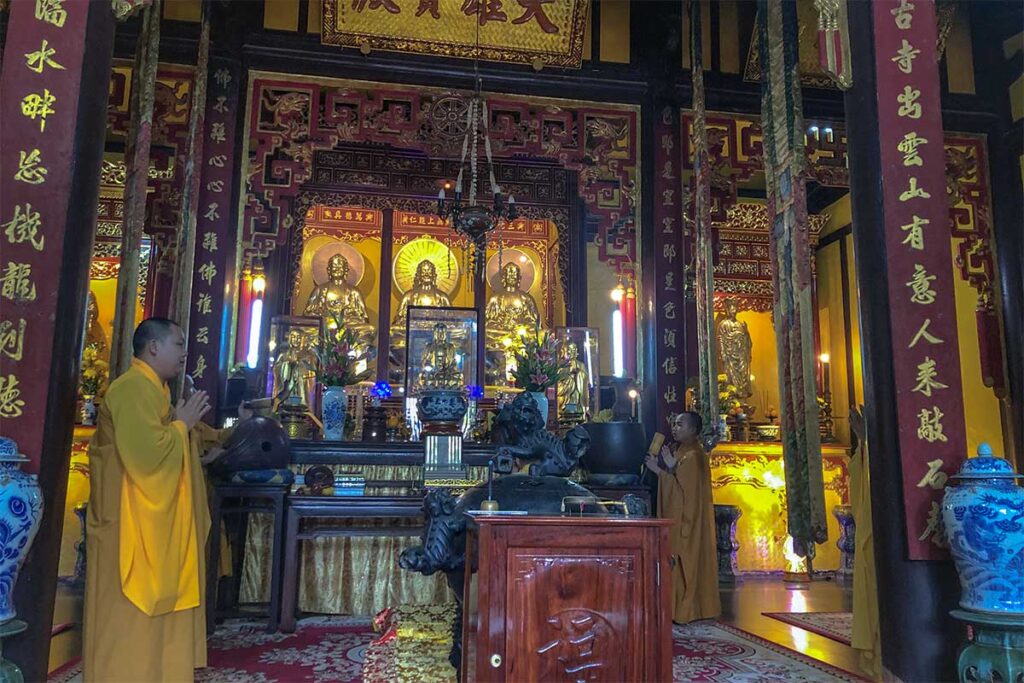
- The four interior pillars are decorated with dragon motifs, representing protection and spiritual strength.
- A small stupa near the front holds what are believed to be relics of Gautama Buddha.
- Other altars feature sacred texts like the Lotus Sutra, and statues of Ananda and Mahakassapa, key disciples of the Buddha.
4. Stupas and memorial towers
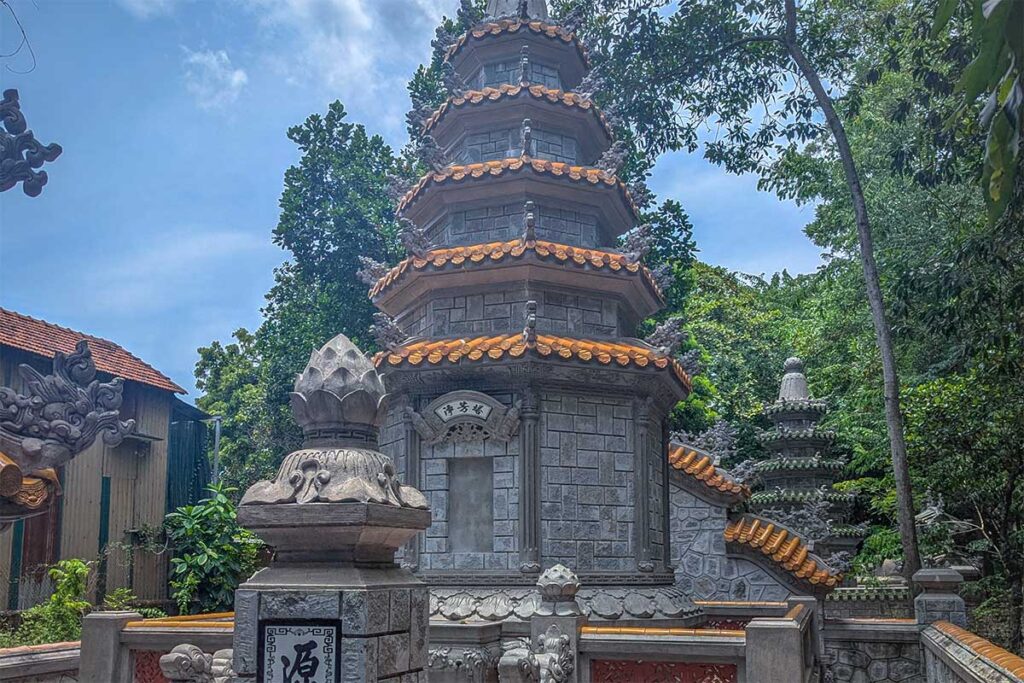
Scattered throughout the grounds are several stupas dedicated to Buddhist patriarchs, including the 3.3-meter stupa of Zen Master Thich Giac Phong, built in 1714. These towers are places of reverence and remembrance for monks who helped shape Vietnamese Buddhism.
5. Quan The Am Bodhisattva Statue
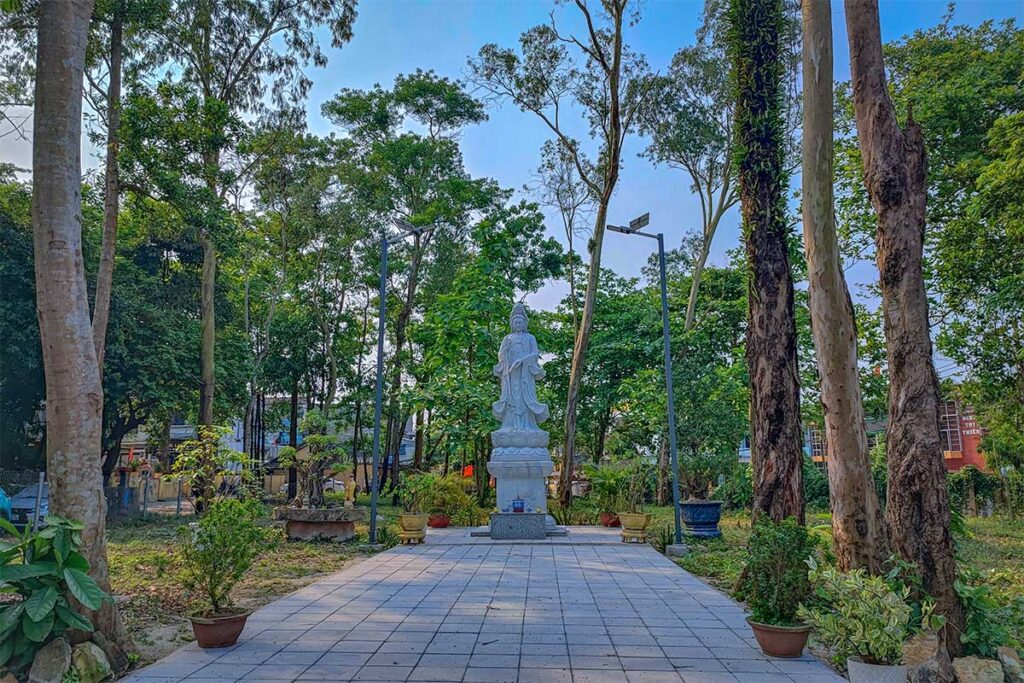
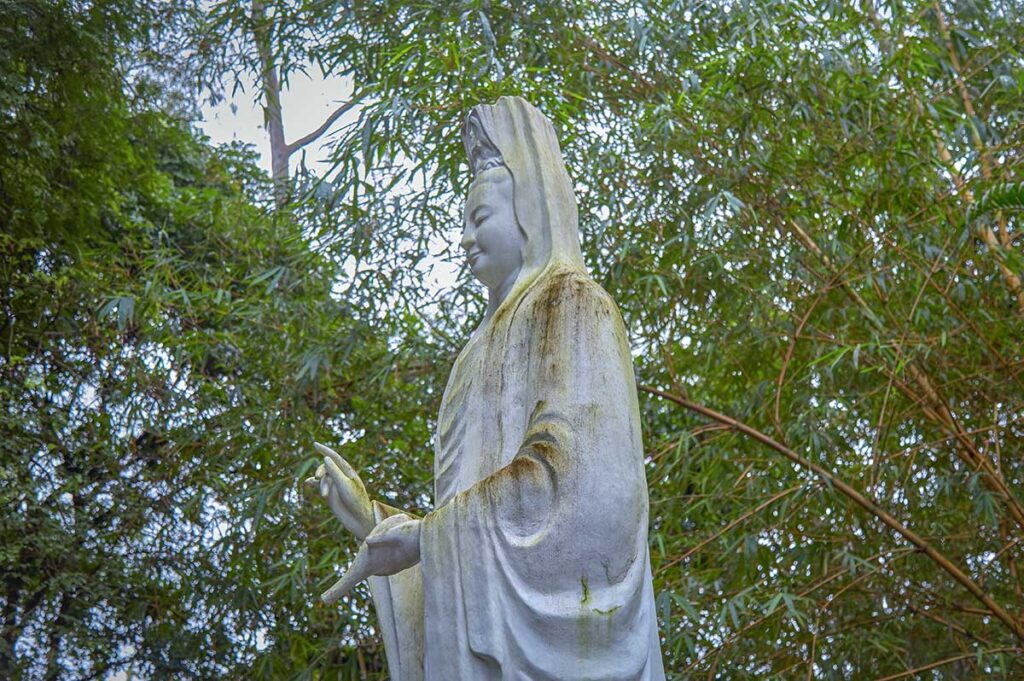
In the courtyard, you’ll see a graceful white statue of Quan The Am (Avalokiteśvara) Bodhisattva, the figure of compassion in Mahayana Buddhism. This is a popular spot for quiet prayer or a moment of stillness under the trees.
6. Ham Long Well
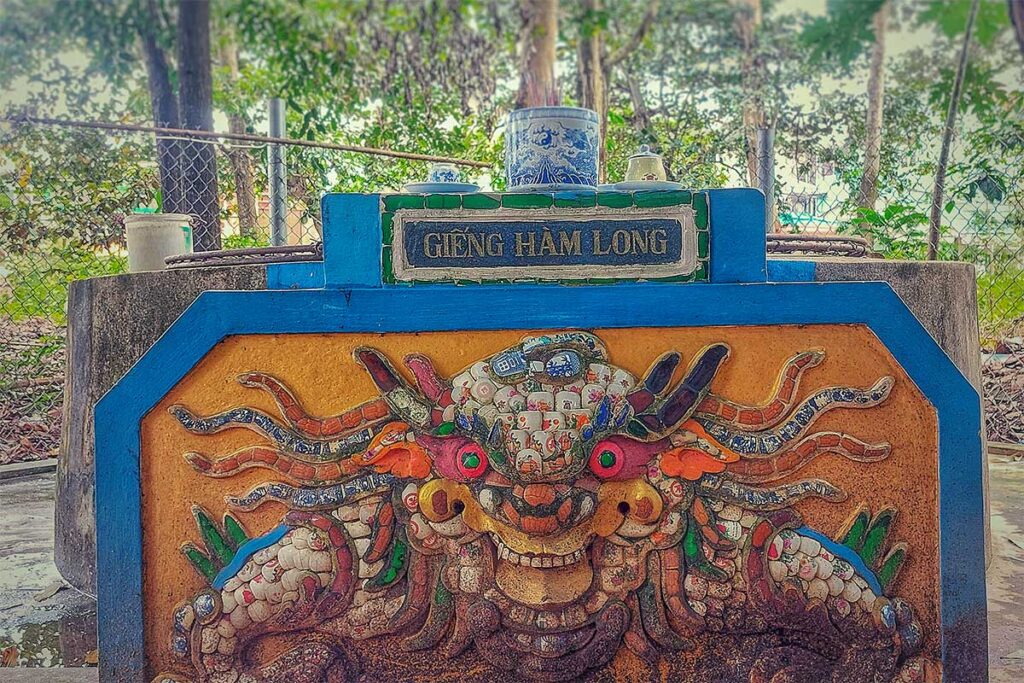
At the base of the hill lies the legendary Ham Long Well, said to have gushed forth when the founder struck the ground.
- One version of the legend ties the well to dragon energy and ancient feng shui rituals during the Nguyen Lords’ rule.
- The water was once considered sacred and used in offerings to the royal court, earning it the nickname “forbidden well.”
These days, locals still see it as a sacred place, and many travelers find it worth a look.
How to get there
Bao Quoc Temple is located on Ham Long Hill, in Truong An Ward, about 2 km southwest of Hue’s city center. It’s easy to reach and makes a convenient stop if you’re heading toward Hue’s imperial tombs.
Address:
Bao Quoc Street, Phuong Duc Ward, Hue City
Taxi or Grab
The most convenient option. It takes around 10 minutes from most hotels or the Imperial City. Grab is widely used in Hue and offers affordable, fixed pricing.
By bicycle
Great for travelers exploring at a slower pace. The roads are mostly flat, with only a mild hill leading up to the pagoda. It’s a peaceful ride if you’re visiting nearby sites like Tu Dam Pagoda or Nam Giao Esplanade.
By motorbike
An easy and flexible option. There’s parking available near the entrance, and it’s simple to combine Bao Quoc Temple with other south Hue attractions on a short self-guided loop.
Visiting information & tips
The temple is open and welcoming, but as an active spiritual site, it’s best to visit with awareness and respect. Here are a few practical tips to keep in mind.
Opening hours
The grounds are typically open from early morning to late afternoon. There is no entrance fee or formal ticketing system.
Dress code
Visitors should wear modest clothing, especially if entering the main hall. Avoid shorts, sleeveless tops, or short skirts. A scarf or light jacket can help if needed.
What to bring
- Water, especially during hotter months
- A camera or phone (use discreetly—no flash or filming during worship)
- Small cash donation (optional, but appreciated at the altar area)
Etiquette
- Avoid burning incense or offering items unless you see locals doing it
- Don’t enter monastic areas, classrooms, or closed doors
- Walk slowly, keep your voice low, and be mindful of those praying or meditating
Nearby sights
Bao Quoc Temple pairs well with other quiet, culturally rich places in the southern part of Hue. While these sites aren’t as famous as the Imperial City or main tombs, they offer a more personal, peaceful experience of the city.
- Tu Dam Pagoda – A historic temple known for its spacious layout, sacred Bodhi tree, and ties to Vietnam’s modern Buddhist movement.
- Nam Giao Esplanade – An open-air imperial altar surrounded by pine trees, once used for royal offerings to Heaven and Earth.
- Phu Cam Cathedral – A bold, modernist Catholic church with striking architecture, located just a few minutes away.
- Tomb of Emperor Duc Duc – A quiet, rarely visited tomb near the city center. Modest in scale but peaceful and uncrowded.
Travel tip:
If you’re heading to the tombs of Tu Duc, Khai Dinh, or Minh Mang, Bao Quoc Temple makes for an easy stop along the way—even if it’s slightly off the direct route. It’s ideal for those who want to explore Hue’s lesser-known spiritual and architectural landmarks at a relaxed pace.
Is it worth visiting?
Bao Quoc Temple isn’t one of Hue’s headline attractions—but that’s exactly what makes it special. For travelers interested in Vietnamese Buddhism, quiet reflection, or the historical layers of Hue beyond the tourist trail, it offers a meaningful and tranquil experience.
If you’re short on time, it’s okay to skip. But if you’re already nearby or curious about Hue’s monastic traditions, royal ties, and spiritual culture, this temple is well worth a short visit.
You can also read our guide about best temples and historical buildings in Hue.

